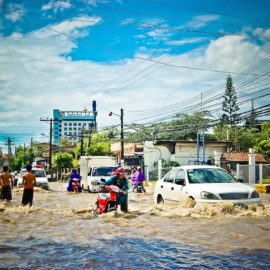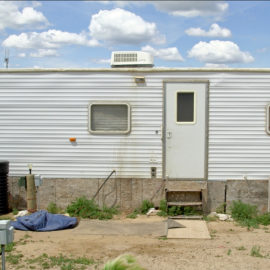
It is hot outside with bad air but there is no disaster. FEMA is being pushed to form this designation.
Extreme heat kills more people than nearly every other weather event combined. But does the government respond to these potentially lethal events as they do with hurricanes and floods? Not yet. A disaster declaration by the president could allow states to be reimbursed for taking action that could save lives — such as opening cooling centers, distributing water and checking in with residents door-to-door. States could also request the Federal Emergency Management Agency to launch an emergency response, such as supplying medical teams or rounding up generators. Yet there has never been a presidential disaster declaration for a heat wave, no matter how deadly. Some say a change is long overdue. “We are living through the realities of climate change,” said San Antonio Mayor Ron Nirenberg, whose Texas city has been blanketed in triple-digit temperatures as part of a heat wave stretching from Florida to New Mexico. “This is an artifact of a bygone era.”
washingtonpost.com
FEMA is doing things to help with the heat.
In response, FEMA Administrator Deanne Criswell said the agency is not “sitting idly by” on extreme heat. She said the agency is helping communities prepare through mitigation funding and spreading awareness about safety. “Heat is the number one natural hazard killer across the United States, and we are seeing a continued increase in the number of heat domes that different communities are experiencing,” Criswell said in a Washington Post Live interview Wednesday. One of the agency’s regional administrators also hosted a first-ever heat summit, she added, where FEMA’s role in helping communities better withstand heat was discussed. Despite those efforts, three declaration requests for extreme heat have been denied, according to a 2022 Congressional Research Service report. A spokesperson for FEMA did not comment on the nature of the requests and the reason for their denial. Other programs at the federal level can help address extreme heat, including within FEMA. The Biden administration touted $2.3 billion in funding for FEMA’s Building Resilient Infrastructure and Communities (BRIC) program, which helps communities increase their resilience to disasters, including heat waves — though it has come under fire for putting heat projects at a disadvantage by considering property damage. “Whatever scoring methodology FEMA uses doesn’t seem to rate lives saved by heat protection measures very highly,” said Michael Gerrard, the faculty director of Columbia Law School’s Sabin Center for Climate Change Law. Gerrard added that pre-disaster preparations are key in responding to heat waves.
There are things that the federal government could to do help the cities impacted.
Laredo Mayor Victor Treviño doesn’t disagree, but he’s aware of how the federal government works. He said grants to build resilient infrastructure can take time, and Laredo’s most vulnerable residents need help now. Though the Texas border city has set up cooling centers, the federal government could help the city provide additional resources, such as strategically distributing air conditioning units, he said. Laredo has notched record-high temperatures that climbed to 115 degrees. At least nine deaths have been recorded from heat-related illnesses in Webb County, according to the medical examiner, and based on past episodes of extreme heat, the true toll is likely higher. “If this is going to be the new norm, yes, absolutely,” Treviño said of the government declaring a disaster for a heat wave. “We need to petition FEMA to come and help us.” Climate change is expected to worsen the frequency, duration and intensity of extremely hot weather, which contributes to heat-related ailments that kill hundreds of Americans every year. According to provisional data from the Centers for Disease Control and Prevention, the United States recorded more than 1,700 heat-related deaths in 2022. “All heat-related deaths and illnesses are preventable,” the CDS said in a report.
Climate change makes heat events more likely.
Some of the record temperatures in Texas were made at least five times more likely by climate change, according to Andrew Pershing, director of climate science at the Climate Central nonprofit. Although Texas is a state accustomed to high temperatures, Pershing said, the record highs and their duration are exceptional for this time of year. He anticipates an increase in hospitalizations and heat-related deaths. “It will appear in the statistics,” he said. While no extreme heat event has received a disaster declaration, it is possible that one could qualify under the Stafford Act, the law addressing federal natural disaster assistance, as either a more limited emergency or a major disaster. Extreme heat is not among the named natural catastrophes that could qualify as a major disaster, but the major disaster declarations for the pandemic suggest that other catastrophes could be eligible. However, to receive either designation, a state must show that the disaster has exceeded its capabilities and resources. And according to former FEMA administrator W. Craig Fugate, heat is comparatively cheap to address — the costs involved are not the same as evacuating people during a hurricane or clearing debris after a tornado. “Does it exceed the state’s capabilities? Are there specific asks for protective measures during a heat wave?” he said in an interview with The Post. “You have to demonstrate that, but I don’t think anybody’s going to be biased to say ‘no’ when lives are involved.”
Some politicians want the heat designation.
Some local and national politicians are hoping to add extreme heat to the list of major disaster-qualifying events to better reflect its threat. In early June, Reps. Ruben Gallego (D-Ariz.), Mark Amodei (R-Nev.) and Sylvia Garcia (D-Tex.) introduced a bill to add extreme heat to the list. In an April letter, Phoenix Mayor Kate Gallego called on FEMA to do the same. She recalled how in 2014, her first year as an elected official, the state received a disaster declaration for catastrophic flooding. The historic flood broke rainfall records, closed schools and left thousands without power. Gallego said FEMA helped Phoenix, a desert community, use sandbags to prevent flood damage and later rebuild. “There’s so much knowledge out there and so much ability for the federal government to provide support,” she said. “We can save a lot of lives if the federal government could declare heat a disaster and partner with local government in addressing it.” Gallego added that the effort has the support of mayors across the country: The United States Conference of Mayors unanimously adopted a resolution calling on Congress to support enabling FEMA to include extreme heat on the list. Meanwhile, the cities and towns in Texas will continue to brace for extreme heat, with triple-digit digit temperatures expected in parts of the state through the weekend. Nirenberg, the San Antonio mayor, said his city is also preparing for high temperatures in coming years as climate change exacerbates weather extremes. “It doesn’t trend the other way,” he said. “The science is pretty clear about that.”
Interesting idea and one with merit. But what couod the Federal government do as they can’t stop the heat!



